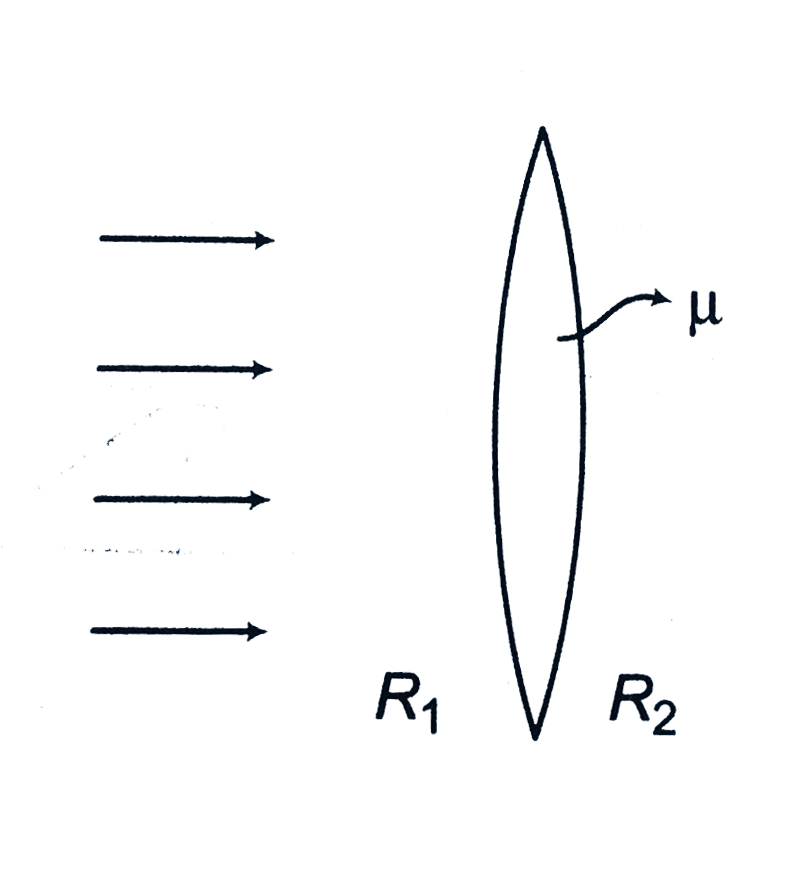A convex lens, μ=1.4 both sides R1, R2 to radius of curvature of both sides. Focal length = ?
1
R1R2
infinity
-1
To find the focal length of a convex lens with a refractive index of μ=1.4 and equal radii of curvature on both sides, we can use the lens maker's formula. The lens maker's formula is given by:
1f=(μ−1)(1R1−1R2)
Step 1: Identify the parameters
Given:
- Refractive index μ=1.4
- R1 and R2 are the radii of curvature of the lens. Since both sides of the lens have the same radius of curvature, we can denote R1=R and R2=−R (the negative sign indicates that the second radius of curvature is on the opposite side of the lens).
Step 2: Substitute the values into the formula
Using the lens maker's formula:
1f=(1.4−1)(1R−1−R)
Step 3: Simplify the equation
Calculating 1R−1−R:
1R−1−R=1R+1R=2R
Now substituting this back into the equation:
1f=(0.4)(2R)=0.8R
Step 4: Solve for the focal length f
Rearranging the equation gives us:
f=R0.8
Step 5: Analyze the result
Since the radius R is not given a specific value, we can conclude that the focal length f is dependent on the radius of curvature R. However, if we assume that the refractive index of the medium surrounding the lens is also 1.4 (which is the case as per the problem statement), then the effective refractive index difference becomes zero, leading to an infinite focal length.
Thus, the final conclusion is:
f=∞
Final Answer:
The focal length of the convex lens is ∞.
Given:
- Refractive index μ=1.4
- R1 and R2 are the radii of curvature of the lens. Since both sides of the lens have the same radius of curvature, we can denote R1=R and R2=−R (the negative sign indicates that the second radius of curvature is on the opposite side of the lens).
Using the lens maker's formula:
Calculating 1R−1−R:
Rearranging the equation gives us:
Since the radius R is not given a specific value, we can conclude that the focal length f is dependent on the radius of curvature R. However, if we assume that the refractive index of the medium surrounding the lens is also 1.4 (which is the case as per the problem statement), then the effective refractive index difference becomes zero, leading to an infinite focal length.
The focal length of the convex lens is ∞.
Topper's Solved these Questions
- JEE MAIN 2021BOOK - JEE MAINS PREVIOUS YEARCHAPTER - JEE MAIN 2021EXERCISE - SECTION-A
80 Videos
- JEE MAIN 2021BOOK - JEE MAINS PREVIOUS YEARCHAPTER - JEE MAIN 2021EXERCISE - SECTION-B
40 Videos
- JEE MAINBOOK - JEE MAINS PREVIOUS YEARCHAPTER - JEE MAINEXERCISE - All Questions
473 Videos
- JEE MAIN 2022BOOK - JEE MAINS PREVIOUS YEARCHAPTER - JEE MAIN 2022EXERCISE - Question
492 Videos
Similar Questions
Knowledge Check
Radius of curvature of a equi convex lens is R. Find focal length (n=32)
AR2B−R2CRD-RRadius of curvature of a equi convex lens is R. Find focal length (n=32)
AR2B−R2CRD-RA plano-convex lens has refractive index 1.6 and radius of curvature 60 cm. What is the focal length of the lens?
A50 cmB100 cmC200 cmD150 cm
A concave lens with equal radius of curvature both sides has a focal length of 12 cm. The refractive index of the lens is 1.5. How will the focal length of the lens change if it is immersed in the liquid of refractive index 1.8 ?
View SolutionA convex lens has the same radius of curvature (R ) for both the surfaces. For what value of the refractive index of the material of the convex lens, the numerical values of f and R are equal ?
View SolutionIf in a planoconvex lens, the radius of curvature of the convex surface is 10cm and the focal length is 30cm, the refractive index of the material of the lens will be
View SolutionStatement-1 : Focal length of an equiconvex lens of μ=3/2 is equal to radius of curvature of each surface.
Statement-2 : it follows from
1f=(μ−1)(1R1−1R2)
View SolutionIf in a plano-convex lens, the radius of curvature of the convex surface is 10 cm and the focal length of the lens is 30 cm , then the refractive index of the material of lens will be
View Solution
